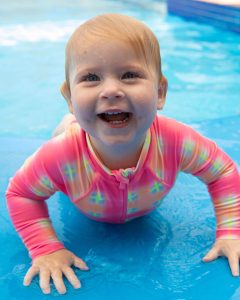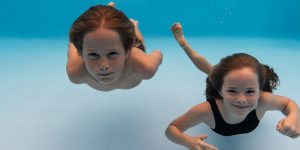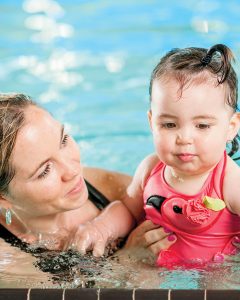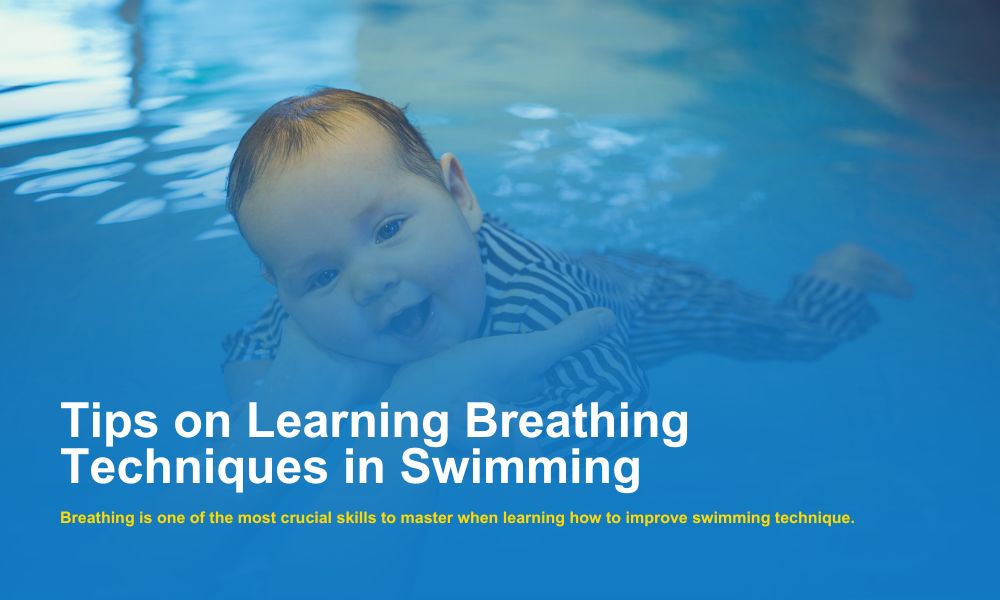Breathing is one of the most crucial skills to master when learning how to improve swimming technique.
Whether you’re a beginner learning how to breathe during freestyle or an advanced swimmer refining your swim breathing technique, developing proper breath control is essential for efficiency, endurance, and confidence in the water.
In this guide, we break down essential swim breathing tips and techniques into several stages to help swimmers of all levels improve their breathing skills:
- Popping Up or Rotating for a Breath
- Developing Breathing Rhythm
- Timing Your Breaths with Arm Movements
- Advanced Breathing Techniques for Freestyle
- Breathing Drills to Improve Technique
1. Popping Up or Rotating for a Breath
For young swimmers or beginners, learning how to breathe while swimming freestyle can be simplified by using two primary techniques: popping up for a breath and rotating onto the back for a breath.
- Popping Up for a Breath:
This technique helps toddlers build a foundation for swim breathing. To succeed, they need basic front sculling skills, the ability to keep their chin close to the water’s surface, and precise coordination to exhale and inhale at the right moment. - Rotating for a Breath:
Rolling onto the back or into a side-floating position is another effective way to learn how to breathe while freestyle swimming.
This technique develops comfort with back-floating, rotation skills, and the ability to inhale while keeping the mouth clear of water.
Both techniques require diminishing assistance from instructors, meaning support is gradually reduced as the swimmer gains confidence.


For more tips, check out our guide on swimming lessons with toddlers.
2. Developing Breathing Rhythm
Consistent breathing rhythm is a key aspect of improving your swim breathing technique. Whether you’re focusing on rotary breathing in swimming or front crawl breathing, establishing a rhythm will help you swim longer without losing breath.
Breathing Exercises for Swimming:
- Exhale fully underwater.
- Surface, take a quick breath, and repeat this cycle 20 times.
- Practice this exercise regularly to build endurance and improve breathing capacity for swimming.
3. Timing Your Breaths with Arm Movements
Proper timing is crucial for mastering the freestyle breathing technique. To synchronize breathing and arm movements:
- Exhale (Bubble): As your “bubbling arm” (the arm closest to the breathing side) begins to pull back through the water, start exhaling.
- Inhale (Breathe): Rotate your head slightly and inhale just before the opposite arm (your “breathing arm”) enters the water.
- Recovery: Ensure your arm recovers fully and extends straight before the next stroke.
This method helps you breathe properly while swimming freestyle without disrupting your rhythm.
Curious about when to start swim lessons? Read more on when to start and stop swimming lessons.
4. Advanced Breathing Techniques for Freestyle
Competitive swimmers often use advanced techniques to optimize their breathing. For instance, rotary breathing in swimming allows swimmers to alternate breathing sides, improving balance and oxygen intake.
Best Breathing Techniques for Swimming
- Bilateral Breathing: Involves breathing every 3-5-7 strokes to alternate sides. This technique enhances symmetry and helps build lung capacity.
- Breathing Every Two Strokes: This is often the most efficient breathing technique for swimming freestyle, particularly in long-distance or competitive scenarios.
Watching elite swimmers like Ian Thorpe demonstrates how breathing strategy plays a crucial role in competitive swimming. Thorpe often adapted his breathing to anticipate challenges, switching sides as needed.


5. Breathing Drills to Improve Technique
To refine your swim breathing technique, incorporate these breathing drills into your practice:
- 3-5-7 Drill: Breathe every 3 strokes, then 5, then 7 to improve lung capacity and breath control.
- Side Balance Drill: Practice floating on your side to improve balance and rotation while breathing.
- Freestyle Breathing Drills: Alternate breathing sides with each lap to develop bilateral breathing skills.
Tips on How to Breathe While Swimming Freestyle
Here are a few key takeaways to improve your freestyle breathing technique:
- Exhale Underwater: Don’t hold your breath. Exhale continuously while your face is submerged.
- Rotate Your Body: Use your core and shoulders to rotate for a breath rather than lifting your head.
- Stay Relaxed: Tension leads to inefficient breathing. Keep your movements fluid and relaxed.
- Practice Consistently: Incorporate swimming breathing exercises and drills into your regular practice to enhance technique and build endurance.
Cold water can pose risks. Stay informed by reading beware of cold water and pools.
Building Breath Capacity for Swimming
If you want to know how to increase breathing capacity for swimming, focus on both in-water and dry-land exercises:
- Swimming Breathing Exercises: Perform breath-hold drills and interval training.
- Breathing Exercises on Land: Try diaphragmatic breathing, yoga, or lung-expansion exercises.
Competitive swimmers often use breath training to improve lung capacity, enabling them to perform at their best.
By focusing on these breathing techniques for swimming, you can build confidence, improve your freestyle swimming breathing, and enjoy more efficient and enjoyable swim sessions. Happy swimming!

